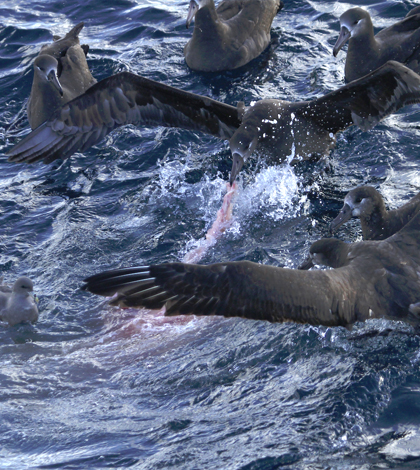Genetic testing helped uncover a killer whale’s unusual victim

The NOAA Fisheries survey vessel plowed through the waves a few hundred miles off the California coast. With access to a suite of acoustic sensors, genetic testing equipment and oceanographic instruments, the researchers onboard were well-prepared to study any marine mammals they came across in their journey along the California Current.
Off the ship’s bow, an observer using powerful binoculars spotted a distant commotion in the water. Distinctive black fins flashed through the churning surf; a sure sign of a killer whale attack. By the time the research vessel made its way to the scene, only a bit of oil, blood and the victim’s heart and lungs remained.
“By the time we got up there, whatever they were preying upon was mostly gone,” said Brittany Hancock-Hanser, a research biologist at the Southwest Fisheries Science Center. “This was the first time I had seen that type of thing before.”
Despite being a newcomer to nautical crime scenes, Hancock-Hanser knew that the scant remains would be more than enough to use in a genetic analysis that could determine the victim’s identity. So she scooped up the leftover organs and prepared them for testing back in the lab.
“This sample, luckily, was fairly fresh,” she said. “If we have samples that aren’t very fresh, that haven’t been preserved, then yeah, we do have complications.”

Killer whales swim past an unusual attack on another whale. (Credit: Paula Olson / NOAA Fisheries)
In the lab, researchers cut tiny pieces of tissue from the heart and lungs. They processed the tissue with enzymes to open its cells, then cleaned it with an alcohol wash. A computer system targeted a fragment of DNA common to cetaceans, then made copies, narrowing the targeted fragment with each copy. In just over a week, the team discovered the victim’s identity.
But why even bother studying what a few whales had for lunch? Hancock-Hanser said this sort of research helps reveal inconsistencies in the whales’ diets. In this case, their meal turned out to be a pygmy sperm whale, a small cetacean that’s hard to come by — and definitely not standard fare for killer whales.
Pygmy sperm whales are deep divers, so they’re not often encountered by researchers on mammal surveys. Furthermore, they don’t make much contact with killer whales. Hancock-Hanser said that the results of this genetic testing could mark the first published interaction between killer and pygmy sperm whales in the Pacific.
The marine mammal surveys that NOAA conducts rely heavily on photo identification, behavioral observation and a keen eye — all factors limited by reaction time and chance. But the genetic sleuthing of Hancock-Hanser and her colleagues gives researchers a means of making up for missed opportunities.
“There aren’t very many instances of [encountering feeding events],” she said. “The good news is, genetics can tell us what they’ve been preying on, even though we weren’t able to observe the actual animal.”
Top image: Albatrosses compete for scraps of the killed whale. (Credit: Paula Olson / NOAA Fisheries)





0 comments